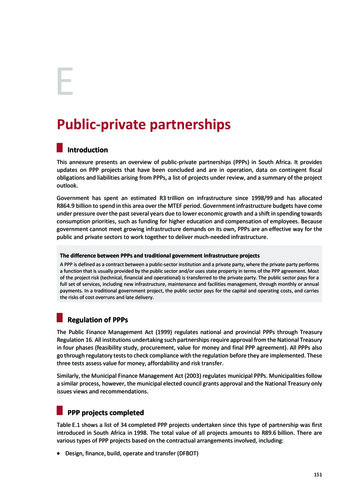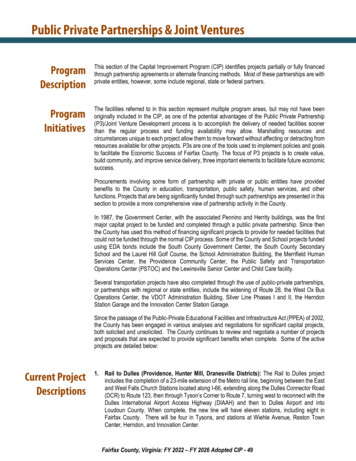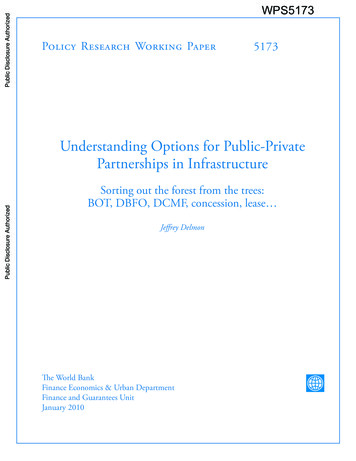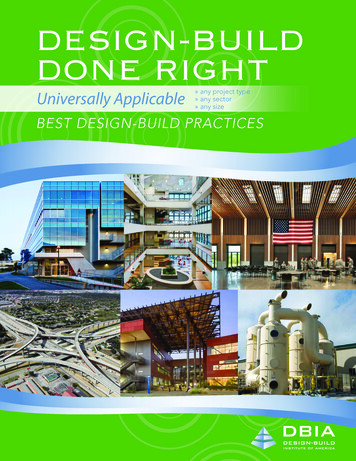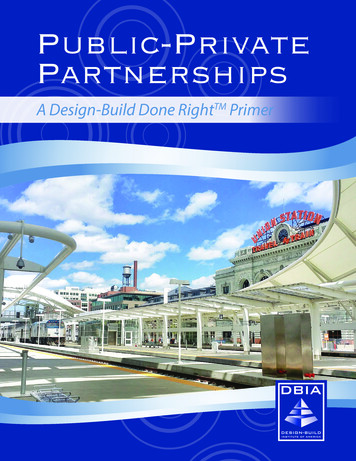
Transcription
Design-Build Public-Private PartnershipsPublic-PrivatePartnershipsA Design-Build Done RightTM Primer1
Public-Private PartnershipsDesign-Build Public-Private PartnershipsA DESIGN-BUILD DONE RIGHT TM PRIMERA DESIGN-BUILD INSTITUTE OF AMERICA PUBLICATIONWritten by the Design-Build Institute of America’s Public-Private Partnership CommitteeBackgroundA public-private partnership (P3) is an innovative project deliverymodel that builds upon the strengths of the design-build deliverymodel. A hallmark of design-build and P3 is upfront collaborationby parties in the design and construction of infrastructure assets thatresults in increased efficiencies. These partnerships work together toserve and benefit the public. The Design-Build Institute of America(DBIA) supports the use of P3s for projects that are able to capitalizeon the strengths of a P3 and recognizes the importance of havingP3 authorizing legislation, policies and best practices that promoteefficient use of the delivery model and leverage existing design-buildbest practices.DBIA has developed this primer to provide a general overviewof common P3 terminology and the benefits and challenges ofundertaking a P3. The information has been gathered from numeroussources and is meant to serve as a starting point for the user to furtherinvestigate and make inquiries regarding the delivery model. SinceP3s are fairly new to the United States, some of the terminology andapproaches may vary from jurisdiction to jurisdiction.IndexI. Definition of P3II. Examples of P3 Contracting ApproachesIII. Sample P3 Structure (DBFOM/DBFM)IV. Key BenefitsV. Common MisconceptionsVI. Risk AllocationVII. Considerations for Design-Build as a Component of a P3VIII. P3 Authorizing LegislationIX. Other ConsiderationsI. Definition of P3In the United States, the definition of a P3 varies and can encompassa broad range of approaches that involve a contractual relationshipbetween the public owner and one or more private sector entities.Some of these P3 contracting approaches are described in section IIbelow. Nonetheless, generally speaking, a P3 is a project deliverymodel that involves an agreement between a public owner anda private sector partner for the design, construction, financing,and often long-term operations and maintenance of one or moreinfrastructure assets by the private sector partner over a specifiedterm. Under the P3 delivery model, the public owner transfers tothe private sector partner risks that are typically retained by the2public owner under a traditional delivery model such as design-bidbuild. Where long-term operations and maintenance obligations areincluded, the degree of risk transfer exceeds that assumed under adesign-build delivery model. P3s also typically use a performancebased approach to technical requirements and specifications, therebycreating an opportunity for the public owner to harness the privatesector’s expertise and innovation and ensure a contractually specifiedlevel of performance of an asset over the term of the P3 agreement.P3 agreements are unique to each public owner as each has its owngoals and challenges which, in turn, will affect how the public entitycan achieve the greatest value through use of a P3. That being said, inmature P3 markets outside of the United States, P3 agreements andprocurement processes have become more standardized.II. Examples ofP3 ContractingApproachesDesign-Build-Operate-Maintain (DBOM)or Design-Build-Operate (DBO)This type of P3 combines design-build with the transfer of operationsand maintenance (O&M) responsibilities to a private sector partner,but does not involve private financing. Under this approach, theproject components are typically procured in a single contract. Notethat a number of transit DBOM projects were ultimately contractedthrough separate design-build and O&M contracts, despite beingprocured together.Design-Build-Finance (DBF)This approach is essentially a design-build combined with shortterm private sector financing of the design and construction. Thepublic owner retains responsibility for long-term O&M. If desired, thefinancing can be structured so that the debt providers do not assumeconstruction nder a DBFOM approach, design, construction, financing, operationsand maintenance responsibilities are transferred to a single privatesector partner. While there are variations within this approach,particularly with respect to the financing component, a commonfeature is the leveraging by the Concessionaire of revenue streamsfrom the project, whether user fees or pre-determined paymentsfrom the public owner, to secure private financing. Projects that rely
Design-Build Public-Private Partnershipson payments from the public owner (such as performance-basedavailability payments) may differ significantly from those projectsfor which the private sector partner directly receives projectgenerated revenues such as customer charges or tolls. The benefits oftransferring demand risk often increase the cost of private financing,and may impact how the P3 ultimately is structured.(sometimes structured as a joint venture of contractors), and an O&Mor facilities management services provider.Design-Build Finance-Maintain (DBFM)Note that not all P3s are structured as shown below. Each project andpublic owner may require specialized approaches to achieve its uniquegoals and objectives, and corresponding private sector solutions.This approach is similar to DBFOM, except the public owner retainsresponsibilities for operations. The DBFM approach has been used forsocial infrastructure such as justice, health and education facilities.III. Sample P3 Structure(Ddfom/Dbfm)The diagram below describes a DBFOM/DBFM P3 structure. A specialpurpose entity (often referred to as “Concessionaire,”“Developer” or“Project Co”) is typically formed to enter into the P3 agreement withthe public owner. The term used in this primer is “Concessionaire.”As between the public owner and private sector partner, theConcessionaire is responsible for the design, construction, financing,and long-term operations and maintenance of the asset. Equity iscontributed, and debt is provided, to the Concessionaire. Although theConcessionaire is the sole counterparty to the public owner under theP3 agreement, the design, construction, operations and maintenanceobligations are typically passed down on by way of subcontract to twoor more key prime contractors – typically, a design-build contractorDue to the complexities of procuring and implementing a P3project, the public owner and private sector entities typically retaintechnical, legal, and financial advisors to assist with the development,procurement and implementation of the project.IV. Key BenefitsEfficient Risk Transfer. A primary benefit of P3s is the abilityto allocate risks inherent in a project to the party best able to managethe risk. In contrast, under a traditional delivery method (and,sometimes, even under design-build delivery) risks are retained by thepublic owner that may be better managed by the private sector. ForP3s that transfer operations and maintenance responsibilities to theConcessionaire, the public owner typically benefits from guaranteedperformance standards and long-term pricing that is locked inthroughout the term of the agreement. Further considerationsregarding risk transfer are discussed in Section VI.Accelerated and On-time Delivery. By leveragingalternative financing tools, bundling multiple projects and/or fullyfunding up front the development, engineering and constructionexpenditures of a given project, P3s can help to accelerate thedelivery schedule of major capital projects by a public owner or, atP3 Sample StructurePublic OwnerProject entsEquityO&M / FacilitiesManagementService AgreementDBOM InterfaceAgreementO&M / FacilitiesManagement ServicesAgreement3
Design-Build Public-Private Partnershipstimes, enable delivery of projects that otherwise would not havebeen undertaken at all. Furthermore, because a significant portion,if not all, of payments or revenue due to the Concessionaire doesnot commence until completion of design and construction, P3sincentivize on-time delivery by the private sector partner.Financial Benefits. While financial benefits of P3s are specificto each project, a few key considerations are discussed below: Public works projects such as toll roads that generate significantuser fee revenues can be delivered with limited governmentalcontribution or borrowing when the Concessionaire retains theproject revenue (and assumes the corresponding revenue risk) toraise private financing. In contrast, projects that do not generatesufficient revenue will need to be supported by governmentinvestment (whether up front or as minimum revenue guarantees),or the revenue risk can be fully retained by the public owner andpayments made by the public owner to the Concessionaire overtime (e.g., performance-based availability payments) can beleveraged by the Concessionaire to raise private financing. Despite a higher cost of private financing than tax-exemptborrowing available to public owners, under the rightcircumstances, a project may be delivered as a P3 at a lower totalcost on a risk-adjusted basis as compared to conventional deliverymethods. Other potential financial benefits include (i) deliveringprojects without impacting the public owner’s borrowing capacity;(ii) preserving market access and credit ratings under traditionalfinancing vehicles; and/or (iii) leveraging public funding availableseveral years out. A key feature of P3 private financing is its non-recourse nature– i.e., lenders to the Concessionaire do not take any interest inthe infrastructure asset itself; instead, its investment is protectedonly to the extent the Concessionaire performs and the publicowner pays in accordance with the project agreements. Therefore,lenders are at risk, both during the design and construction andthe operations and maintenance phases, if the project does notsucceed. This alignment of interests between the public owner andlenders creates an added layer of oversight and discipline underthe P3 delivery model that does not exist under traditional deliverymethods (e.g., where lenders are repaid regardless of projectcompletion or performance). With inclusion of long-term O&M and major maintenanceobligations in the Concessionaire’s responsibilities, the publicowner can also obtain the benefit of price certainty for long-termO&M with guaranteed performance standards, which is not alwaysbudgeted when a project is delivered conventionally.Lifecycle Benefits. One of the key benefits of P3s thatinclude O&M scope is the ability to maximize lifecycle efficiencies.The performance-based nature of P3s incentivizes the private sectorpartner to take into account and manage the O&M and lifecycle4costs from the outset when designing and constructing the asset.Furthermore, P3s can also offer an effective way to incentivizeenergy efficiencies and savings by contractually mandatingenergy consumption targets and sharing the benefits and costs ofdeviations from such targets (i.e., “gainshare” and “painshare”).Therefore, if used appropriately, a P3 may enable a public ownerto leverage the expertise and innovation of the private sectorand long-term performance guarantees to achieve savings andefficiencies often not possible under other delivery methods.V. CommonMisconceptionsMisconceptions about P3s can hinder the appropriate assessmentand use of the model, particularly in jurisdictions where P3s remainuntested. Common misconceptions include the following: “P3s are funding sources” – P3s are not funding sources.The user fees or tax dollars used to pay for a P3 exist (or don’texist) regardless of whether a P3 is used. “All risks should be transferred to the private entity”– Some risks are generally better managed by the public owner,such as the use of eminent domain necessary to acquire theproject right-of-way, securing most environmental approvals,and other major planning requirements. “P3s are appropriate for every project” – P3s mayprovide best value for money for certain projects over the longterm. However, in order to be efficient, the project must be ofsufficient size. In other cases, delivery methods such as designbuild or construction manager-at-risk may be better suited to aproject. P3 is only one option among several. “P3s involve transfer of public assets to the privatesector” – The private sector partner does not obtain any realproperty interest in the asset under a concession or availabilitypayment P3. Under a lease-based P3 structure, the publicowner also ultimately owns the asset.
Design-Build Public-Private PartnershipsVII. Considerationsfor Design-Build as aComponent of P3VI. Risk AllocationA P3 provides opportunities for efficient risk transfer. Any risk transfercomes with a cost that needs to be assessed by the public owner froman affordability and value for money standpoint as the P3 agreementis developed. Some risk areas to be considered include: Design Risks – design and engineering risks such asgeotechnical, lifecycle design adequacy, environmental andapproval standards; Construction Risks – constructability risks, means andmethods, schedule, safety, quality, commissioning, startup andrelated construction risks; Availability Risk – whether the asset will reliably provide therequired level of services required under the P3 agreement; Demand Risk – the potential that the actual demand for use ofthe service is lower than anticipated, often resulting in financingdownside due to reduced project revenues; O&M Risks – risks associated with the operation andmaintenance that may occur due to shortages or change in costsof materials and supplies, changes in labor costs, deferred costs,obsolescence; Residual Value Risk – difference between the asset value ofthe infrastructure at the end of the P3 agreement and the originalvaluation, as this may require additional unforeseen rehabilitationwork/investment; andIn a P3 that includes private financing, the Concessionaire typicallypasses down substantially all of its design and construction obligationsunder the P3 agreement to a single design-build contractor byconcurrently entering into a design-build agreement with the designbuild contractor. Therefore, the role of a design-build contractor indelivering the design and construction portion of a P3 is similar todelivering a stand-alone design-build project directly for the publicowner. However, there are a few key differences, including thefollowing: Lifecycle Design – P3s balance long-term, robust designto meet lifecycle requirements with an affordable design-buildapproach. Lender Protection – In a P3, the design-build contractoris required to post security in favor of lenders (e.g., daily delayliquidated damages are set forth in the design-build agreementand the design-build contractor must provide a letter of credit andparent company guarantees); this typically does not happen to thesame degree in standard design-build projects. Quality Management – In a P3, the Concessionaire oftenhas a significant role in quality assurance and quality control, inaddition to the design-build contractor’s responsibilities. Reporting – In a P3, the design-build contractor is responsiblefor detailed reporting to both the Concessionaire and the publicowner (along with any reporting completed by third parties suchas the lender’s technical advisors and independent technicaladvisors). Interface With Team Members – In a P3, the design-buildcontractor will be required to enter into (i) a direct agreement withlenders, providing lenders with a right to step in and remedy anyof the Concessionaire defaults under the design-build agreementprior to any termination by the design-build contractor; and (ii) aninterface agreement with the O&M/facilities management servicesprovider. Financing Risk – risk that the necessary financing will beobtained and that interest rates may prevent the financial lifecycleof the project from meeting the program objectives.Photo Credits:Above: The Claude “Bud” Lewis Carlsbad Desalination Plant ; Owner: Poseidon Water LLC,2016 National Design-Build Award Winner; Right: Governor George Deukmejian Courthouse;Owner, State of California Judicial Council, Administrative Office of the Courts; 2014 NationalDesign-Build Excellence in Design Award, 2014 National Design-Build Award of Merit.5
Design-Build Public-Private PartnershipsVIII. P3 AuthorizingLegislationDeveloping and implementing a P3 is a time- and resource-intensiveundertaking for the public and private sector participants. Therefore,it is important for all participants to know in advance of investingconsiderable resources that the public owner has the requisite legalauthority to undertake a project as a P3. Such authority may be foundunder existing, non-P3-specific legislation or P3-specific legislationmay exist or need to be enacted to provide sufficient authority.Furthermore, where sufficient legal authority exists, it is equallyimportant to ensure that the procurement of the project and theultimate P3 agreement comply with applicable legal requirements soas to mitigate the risk of successful challenges to the project.A more detailed summary of P3 authorizing legislation at the statelevel as well as the latest update of the map below can be found underthe public-private partnership resources page at www.dbia.org.is a key consideration for the viability of a P3 project. As the fate ofa number of recent projects have demonstrated, P3s in the UnitedStates are particularly vulnerable to changes in political climate overthe life of their procurement and implementation, in comparison tomore mature P3 jurisdictions such as Canada, the UK or Australia.Therefore, to increase the chances of success, it is important that (i)any political approvals necessary for a P3 project be obtained as earlyas possible, (ii) stakeholder engagement is consistently undertakenby all participants throughout the procurement and implementationphases, and (iii) procurement is completed within a favorable politicalwindow. Furthermore, it is essential to have a political champion whocan help guide the project through is various challenges and addressstakeholder concerns.Notwithstanding these challenges, however, there are tremendous,untapped opportunities for P3s in the U.S. market, where projectsthat are well-suited for P3 delivery, if properly executed, can help todeliver critically needed infrastructure to communities in a timely andcost-effective manner.IX. OtherConsiderationsFor further information regarding P3,visit the public-private partnership resources page atwww.dbia.org or contact us at DBIA@dbia.org.Particularly in the United States, where P3 is emerging as a potentialdelivery model but has not yet been widely embraced, political riskOverview of P3 Authorization by State(as of October 2016)6
Design-Build Public-Private Partnerships“DESIGN-BUILD DONE RIGHT” AND CERTIFICATIONCertification provides the only measureable standard by which to judge an individual’s understanding of "design-build done right.”DBIA certification in design-build project delivery educates owners as well as designers and builders on team-centered approaches todesign and construction. Owners want successfully executed design-build projects and are looking for a demonstration of both relevantcontinuing education and experience – both of which can be gained through DBIA certification.DBIA offers two types of Certification.DESIGN-BUILDPROFESSIONALAttaining the DBIATM requires from two to six years of hands-on experience of pre and postaward design-build. Credential holders who display “DBIA” after their names come fromtraditional design and construction backgrounds; they are private or public sector architects,engineers and construction professionals. Some attorneys and academic practitioners whospecialize in design and construction generally and design-build specifically may also fulfillthe DBIA requirements.Unlike the DBIATM credential, obtaining the Assoc. DBIATM does not require hands-on fieldexperience. Instead, this credential is focused on three key types of individuals who possessa different type of experience: (1) pre-award professionals focusing on critical aspects of thedesign-build process such as business development and acquisition/procurement; (2)seasoned professionals who are new to design-build project delivery, but not new to thedesign and construction industry; and (3) emerging professionals such as recent collegegraduates with relevant educational background in the AEC industry.For more information, visit www.dbia.org/certification7
DESIGN-BUILD DONE RIGHTTMPRIMERA DESIGN-BUILD INSTITUTE OF AMERICA PUBLICATIONCopyright October 2016DBIA extends thanks to all of the industry leaders who helped shape this document.A special thanks is extended to DBIA’s Public-Private Partnership CommitteeChair, Yukiko Kojima, Nossaman, LLPand Vice-Chair, Susan Roberts, PhD, PG, Texas A&M Engineering Center for Applied TechnologyCover Photo CreditDenver Union Station Transit Improvements,a Public-Private Partnership and 2014 National Design-Build Project of the Year Award Winner.
P3 agreement, the design, construction, operations and maintenance obligations are typically passed down on by way of subcontract to two or more key prime contractors - typically, a design-build contractor (sometimes structured as a joint venture of contractors), and an O&M or facilities management services provider.



